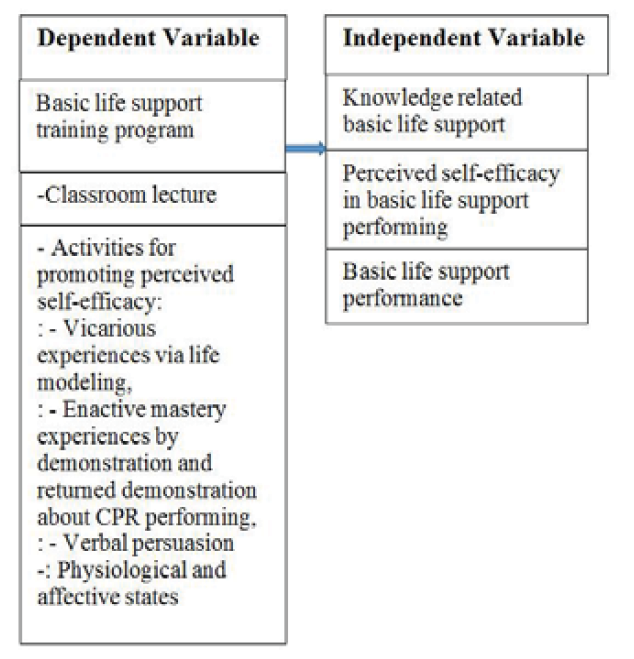Effects of basic life support training program on knowledge, perceived self-efficacy, and basic life support performance of village health volunteers
Main Article Content
Abstract
Out-of-hospital cardiac arrest is the leading cause of death worldwide. Performing basic life support immediately can decrease the mortality rate. The purpose of this quasi-experimental, one group pre-post-test design was to compare knowledge related to basic life support, perceived self-efficacy in a basic life support and basic life support performance among village health volunteers before and after participating in the basic life support training program which applied self-efficacy theory. The participants were 37 village health volunteers of Nong Ngu Luam sub-district, Nakhon Pathom Province. These volunteers met the inclusion criteria and were purposively selected into the study during September to October 2018. The participants received the basic life support training program including receiving classroom lectures related to basic life support and receiving training for promoting perceived self-efficacy via the following methods. These were through life role model, practical CPR training, verbal persuasion and identification of symptoms indicating conditions which need treatment. The knowledge related basic life support, perceived self-efficacy in basic life support, and basic life support performance were evaluated at baseline and immediately following the training. The data was analyzed using descriptive statistics and the paired samples t-test. Results showed that a mean score of knowledge related basic life support, perceived self-efficacy in basic life support performing, and basic life support performance after participated the program were significantly higher than before participating the program (pvalue < 0.001). The results also revealed that all participants passed the minimum test criteria for basic life support performance. The results demonstrated that the basic life support training program is an effective program. It is therefore concluded that this program should be implemented in another similar contexts in the community in order to save the life of casualties who experience out-of-hospital cardiac arrest.
Article Details
References
J. Berdowski, R. A. Berg, J. G. P. Tijssen, R. W. Koster, Global incidences of out-of-hospital cardiac arrest and survival rates: Systematic review of 67 prospective studies, Resuscitation 81(11) (2010) 1479-87.
M. E. Ong, S. D. Shin, N. N. De Souza, H. Tanaka, T. Nishi-uchi, K. J. Song, et. al., Outcomes for out-of-hospital cardiacarrests across 7 countries in Asia: The Pan Asian Resuscitation Outcomes Study (PAROS), Resuscitation 96 (2015) 100-8.
P. S. Chan, B. McNally, F. Tang, A. Kellermann, Recent trends in survival from out-of-hospital cardiac arrest in the United States, Circulation 130(21) (2014) 1876-82.
S. Ozbilgin, M. Akan, V. Hanci, C. Aygun, B. Kuvaki, Evaluation of public awareness, knowledge and attitudes about cardiopulmonary resuscitation: report of izmir, Turk J Anaesthesiol Reanim 43(6) (2015) 396-405.
F. Dobbie, A. M. Macklintosh, G. Clegg, R. Stirzaker, L. Bauld,Attitude towards bystander cardiopulmonary resuscitation: Results from a cross-sectional general population survey, PLOSONE 7(March) (2018) 1-8.
Y. S. Roh, S. B. Issenberg, Association of cardiopulmonary resuscitation psychomotor skills with knowledge and self-efficacy in nursing students, International Journal of Nursing Practice 20(6) (2014) 674-9.
S. Partiprajak, Relationship between knowledge, perceived self-efficacy in basic life support (BLS) and chest compression performance among undergraduate nursing students, Songklanagarind Journal of Nursing 35(1) (2015) 119-134. (in Thai)
J. Buathongiun, S. Teerawatskul, U. Suttineam, Effect of basic life support program on basic life support xcompetency in the supporting staff of Boromarajonani college of nursing,Bangkok, Boromarajonanicollege of nursing, Uttaradit Journal10(1) (2018) 70-83. (in Thai)
A. Bandura, Self-Efficacy: The Exercise of Control, New York:Freeman (1997).
Burea of Non Communicable Diseases [Internaet]. Number and mortality rate of non-communicable diseases 2016 - 2017 [cite 15 Oct 2018], Available from: http://www.thaincd.com/2016/mission/documents.php?tid=32&gid=1-020.
J. Cohen, Statistical power analysis for behavioral sciences(2nd ed.), Hillsdale, NJ: Lawrence Erlbaum Associates (1988).
B. S. Bloom, J. T. Hastings, G. F. Madaus, Handbook on formative and summative evaluation of student learning, New York: McGraw-Hill (1971).
American Heart Association [Internet]. 2015 American Heart Association Guidelines Update for Cardiopulmonary Resuscitation and Emergency Cardiovascular Care [cite 15 Oct 2018]. Available from: https://www.cercp.org/images/stories/recursos/Guias%202015/Guidelines-RCP-AHA-2015-Full.pdf
H. Rahmati, F. Yaghoubinia, R. Z. Mehrabady, Comparing the effect of lecture-based and basic life support training package on cardiopulmonary resuscitation knowledge and skill of teachers, Health Scope 6(3) (2017) e15165: 1-7.
W. Waelveerakup, M. Jamnain, J. Poopitukkul, The Effect of self-efficacy teaching program on confidence in self-performance and basic resuscitation skills of teachers in Nakhon Pathom Province schools. Proceeding of National Academic Conference on the topic of innovation and technology in trauma and emergency nursing: quality, safety and care continuum. Thumrin Thana Hotel, Trang Province, Thailand: December 3-4, 2018: 33-45. (in Thai)
V. Gonz`alez-Salvado, F. Fern`andez-M`endez, R. Barcala-Furelos, C. Pena-Gil, J. R. Gonz`alez-Juanatey, A. Rodr`iguez-Nunez, Very brief training for laypeople in hands-only cardiopulmonary resuscitation. Effect of real-time feedback, The American Journal of Emergency Medicine 34(6) (2016) 993-8.


